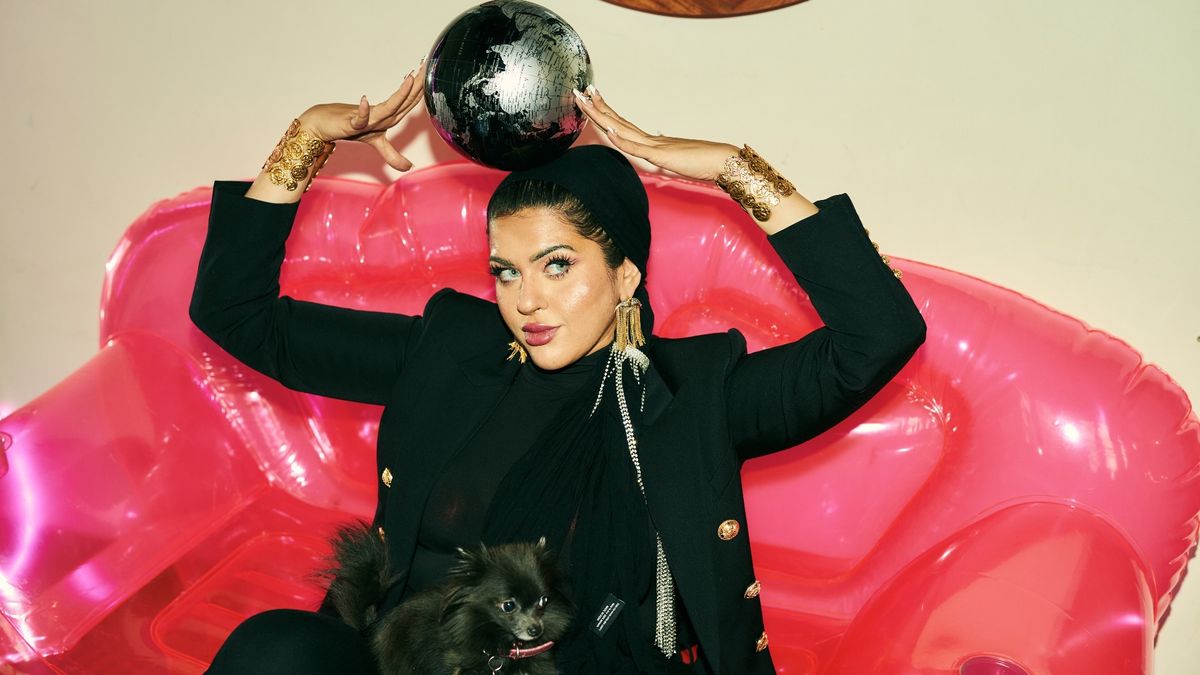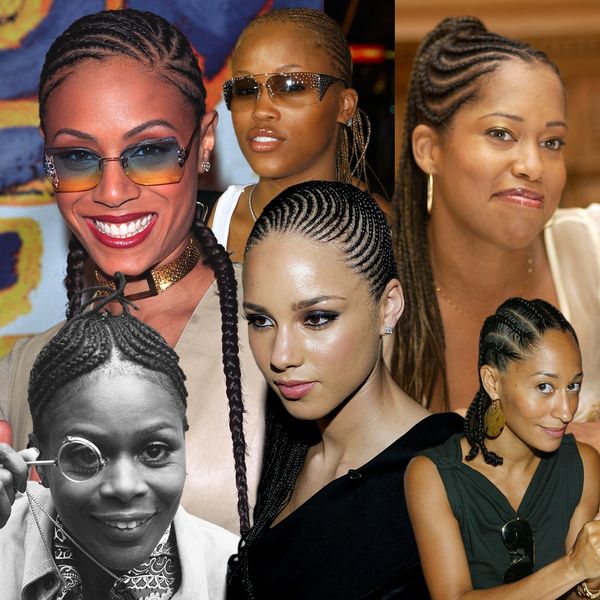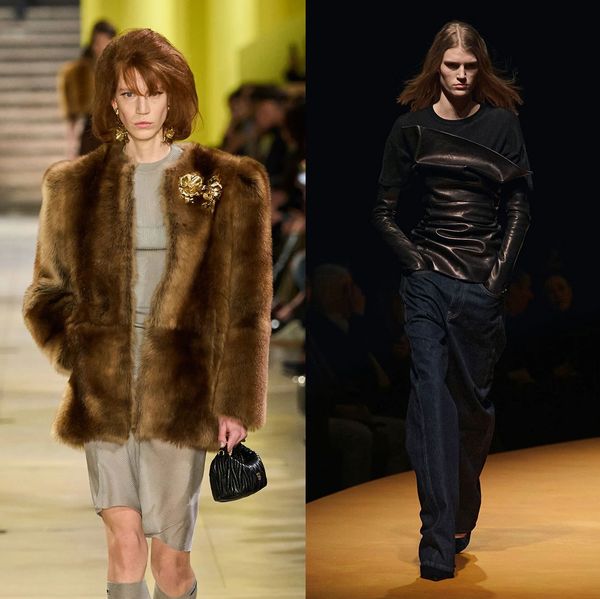"Muslim Girl" Founder Amani Al-Khatahtbeh's Closet Has Room for Glamour & Modesty
Think sharply tailored blazers, tons of sneakers, and a whole lot of pink—all of which make her feel powerful.

“I seriously was obsessed with this editorial because it was the only one that I ever found that was like this,” says Amani Al-Khatahtbeh, founder of MuslimGirl.com, author of Muslim Girl: A Coming of Age, and Forbes 30 Under 30 recipient. The editorial in question is from a 2005 issue of Marie Claire featuring numerous women in hijabs and abayas (traditional Muslim robes) carrying the season’s most coveted accessories. “It was this fusion of culture and contemporary trends that I had never seen before,” Al-Khatahtbeh continues. “It was like, ‘Oh my God, this is cool. This shows the potential of rebranding the way we're perceived as just being oppressed or that we have no say in the way that we express ourselves.’" She sent me the scanned images via email. They are teeny tiny files, so blurry I can barely make out the details. These files have followed her via hard drive through decades and computers—she’s made sure of it.
“There were no examples, no [style] icons,” Al-Khatahtbeh explains of the state of media in the early 2000s as she was cultivating her own sense of style with respect to Muslim ideals. (She often looked towards archival imagery—old Arab Hollywood glamour specifically—to shape her self-expression.) “And then every now and then there’d be one gem in the rough with some type of representation within the editorial world.”
Growing up in New Jersey in the wake of 9/11, Al-Khatahtbeh watched the media become extremely critical of Muslims—and that criticism often centered around what they wore in a very negative fashion. Frustrated, she launched Muslim Girl from her high school bedroom as a place to “talk back,” and reclaim the narrative of their culture in the media. There, they have conversations about everything from best nail polish practices to Shemima Begum’s courtroom proceedings—"the things that were actually directly relevant to our lives."
She wants young Muslims to have a space to share and consume stories like her own. At thirteen, Al-Khatahtbeh chose to adopt the hijab in her everyday wardrobe, effectively setting the pretense for a sartorial life of modesty. The tween had just traveled to the Middle East for the first time, experiencing what she describes as her “first exposure to my background and my culture from the source and not from what all the post-911 propaganda was telling me.” The choice to don the traditional Muslim headscarf was more about identity than fashion—though the sartorially obsessed will tell you that’s what all fashion decisions are. “Obviously the hijab is very much a religious symbol. It is very much an act of faith, an expression of our spirituality,” she explains. “But for me, it became my testament that I exist and I belong here and there's nothing that anyone can do to take me away from who I am.”
But in doing so, Al-Khatahtbeh didn’t want to give up her love of fashion. “When I think about glamour, I think it's taking great pride in your own personal beauty and what you have to offer.” The entrepreneur accessories her hijab with great big baubly earrings and shimmering pink eyeshadow. "It can get a little gaudy, I will admit, especially with all the rhinestones, because again, Jersey girl," she laughs. "I've got to stay true to my first culture." She knows that her take on the headscarf skews progressive. "I don't shy away from using it as a way to express myself in a way that feels meaningful to me and not just the traditional way that we're expected to wear it. But it always comes with some sort of intention.”
The world of accessories offered an easier step-in for the budding fashionista. Not only was Al-Khatahtbeh forced to find modest clothes in New Jersey, she was also relegated to plus-sized options, a sector that’s still underserved today. “I was suddenly excluded from being able to dress the way that I wanted to dress that also fit my body that also was modest and covered me up the way that I wanted to. And that lack of accessibility of the fashion trends that I was so eager to participate in was an affirmation that I didn't belong.”
When we visited Al-Khatahtbeh in her Los Angeles home, she wore a pink corset (the signature color of 'Muslim Girl') layered over a black turtleneck. “You wouldn't expect that a Muslim Girl would be able to wear [a corset],” she says, but these are the sorts of challenges Al-Khatahtbeh delights in. She takes fashion’s favorite tactic of layering to a whole new degree, reinterpreting what society deems off-limits.
Forced to make a choice as a tween of how she wants to outwardly depict her faith, Al-Khatahtbeh weighs a lot of her fashion choices with that same reverence for identity. The young entrepreneur loves a blazer for its literal corporate symbolism—and loves to wear it with blingy jewelry and her hijab. "When I put on a blazer, it makes me get into my boss bitch mode," she explains. On the opposite side of that sartorial pendulum swing, Al-Khatahtbeh champions athleisure in her day-to-day. "My daily uniform is Adidas, usually head to toe." (She has also collaborated with Adidas on her own capsule collection). A self-dubbed sneakerhead, her collection includes numerous pairs of white high-tops. Mixing sneakers in with fancier items “almost feels like that notorious meeting from The Social Network when Mark Zuckerberg went into that huge investment office wearing his pajamas.” Plus, standing at 5’9’’, Al-Khatahtbeh relishes in the comfortable sweetness of rejecting “torturous” heels.
Though the act of selecting a pair of Adidas sneakers might not seem like a luxury to most, no fashion choice of Al-Khatahtbeh’s lacks intention. In fact, the greatest strength she derives from fashion is not siphoned from a blazer or a pair of sneakers, but the ability to control what she puts on her own body. “For Muslim women and a lot of women that have been on the periphery of mainstream society, it really comes down to choice for us,” she summarizes. “And I think over the years, being able to harness the way that I express myself through fashion and have more creative freedom reflected my feelings of power in society. And now I feel the most free that I ever have been when it comes to the way that I express myself with fashion.”
Want more stories like this?
Inside the Closet of Travis Barker's Sneaker-Obsessed Closet
There Are No Rules in Ziwe's Closet
Susan Alexandra's Founder Has A Closet Full of Moschino 'Cheap and Chic' and Some Serious Florals




